SQUATTING AT THE SAVOY 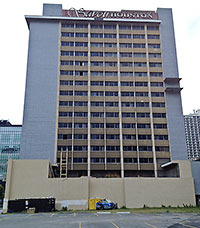 The news that Downtown’s old Savoy Hotel has been sold and will be converted into a Holiday Inn seems to have inspired some nostalgia in the Houston Chronicle’s Craig Hlavaty. Going back over the hotel’s past as housing for law students and even boarding for Lee Harvey Oswald, in town one day to apply for a job at nearby Conoco, Hlavaty also finds evidence that the supposedly vacant building was anything but: “In 2004, someone named “squatterkid” was posting on a Houston architecture forum about living inside . . . even getting phone calls there from people expecting to make reservations at the long dormant hotel. The number was still listed. At the time, he said that there was still electricity running in the place, too. The squatter, who went by Sean when he spoke with the Houston Press in 2007, said he and some homeless folks made the hotel their home using the leftover furnishings.” You can read more from “squatterkid” here. [Houston Chronicle; HAIF; previously on Swamplot] Photo: Allyn West
The news that Downtown’s old Savoy Hotel has been sold and will be converted into a Holiday Inn seems to have inspired some nostalgia in the Houston Chronicle’s Craig Hlavaty. Going back over the hotel’s past as housing for law students and even boarding for Lee Harvey Oswald, in town one day to apply for a job at nearby Conoco, Hlavaty also finds evidence that the supposedly vacant building was anything but: “In 2004, someone named “squatterkid” was posting on a Houston architecture forum about living inside . . . even getting phone calls there from people expecting to make reservations at the long dormant hotel. The number was still listed. At the time, he said that there was still electricity running in the place, too. The squatter, who went by Sean when he spoke with the Houston Press in 2007, said he and some homeless folks made the hotel their home using the leftover furnishings.” You can read more from “squatterkid” here. [Houston Chronicle; HAIF; previously on Swamplot] Photo: Allyn West
Quicklink
POST OAK BRT THAT MUCH CLOSER TO GETTING ITS MONEY 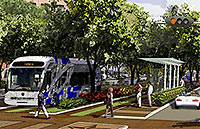 After a month’s delay to take a longer look at the project, the transportation arm of the Houston-Galveston Area Council finally decided to go ahead and recommend that Uptown receive $62 million in federal funds to pay for the proposed Post Oak Blvd. bus rapid transit system. This is just a provisional step, of course, since 2 actual approvals, not mere recommendations, are needed — but it does move things along. Through tax revenue, Uptown is already paying for about half the estimated $148 million project. The Houston Chronicle’s Dug Begley is reporting that this federal money would help buy up $30 million of land so Post Oak could be widened for the bus lanes. [Houston Chronicle; previously on Swamplot] Drawing: Uptown Management District
After a month’s delay to take a longer look at the project, the transportation arm of the Houston-Galveston Area Council finally decided to go ahead and recommend that Uptown receive $62 million in federal funds to pay for the proposed Post Oak Blvd. bus rapid transit system. This is just a provisional step, of course, since 2 actual approvals, not mere recommendations, are needed — but it does move things along. Through tax revenue, Uptown is already paying for about half the estimated $148 million project. The Houston Chronicle’s Dug Begley is reporting that this federal money would help buy up $30 million of land so Post Oak could be widened for the bus lanes. [Houston Chronicle; previously on Swamplot] Drawing: Uptown Management District
FLESHING OUT WILLOWBROOK’S DINING OPTIONS  Rivals in that niche sports-and-cleavage market Twin Peaks and Hooters will have a bit more competition starting today, reports Eater Houston, and this from the only restaurant that’s legally allowed to call itself a “breastaurant:” Bikinis Sports Bar and Grill — which in April trademarked the term — opened its first location last month in The Woodlands; this new one will be at the former Burger Girl at 17117 Tomball Pkwy. near the Willowbrook Mall. And what, you might wonder, sets Bikinis apart? It might be the food: “In addition to traditional American bar-and-grill fare and cocktails and microbrews,” reports the Houston Business Journal, “Bikinis offers its Big Bucking Burger. Customers can win a T-shirt if they finish the $24.95 five-pound burger on their own.” [Eater Houston; Houston Chronicle; Houston Business Journal] Photo: Bikinis Sports Bar and Grill
Rivals in that niche sports-and-cleavage market Twin Peaks and Hooters will have a bit more competition starting today, reports Eater Houston, and this from the only restaurant that’s legally allowed to call itself a “breastaurant:” Bikinis Sports Bar and Grill — which in April trademarked the term — opened its first location last month in The Woodlands; this new one will be at the former Burger Girl at 17117 Tomball Pkwy. near the Willowbrook Mall. And what, you might wonder, sets Bikinis apart? It might be the food: “In addition to traditional American bar-and-grill fare and cocktails and microbrews,” reports the Houston Business Journal, “Bikinis offers its Big Bucking Burger. Customers can win a T-shirt if they finish the $24.95 five-pound burger on their own.” [Eater Houston; Houston Chronicle; Houston Business Journal] Photo: Bikinis Sports Bar and Grill
COMMENT OF THE DAY: NEIGHBORHOOD NAMES STICK “Alief didn’t start getting rebranded as the International District till about 3 years ago; as a matter of fact, no one that lived there knew anyone was calling it something other than Alief. It wasn’t until they put those idiotic balls in the medians that anyone local knew someone was calling it something other than Alief. The Super Neighborhood is still called Alief. Hong Kong City Mall was transformed from a pasture to a Mall over a decade ago, that huge strip center at Wilcrest and Bellaire is almost as old. Maybe in 40 or 50 years people may latch onto the name International District in favor of Alief, but then they’re going to wonder why the Library is still called Alief Regional Library, and the school district is still Alief Independent School District, or why the community center is called Alief Community Center. Or why there’s a animal hospital called Alief Animal Hospital. I have a strong suspicion Alief will always be called Alief, no matter how many weird balls they put in the medians. And I’d also rather just call it Montrose and have people ask me if I’m gay than call it Lower Westheimer and have the 15 minute discussion about where it is, and the end result being that I tell them it’s the new name for Montrose and I’ll still be asked if I’m gay.” [toasty, commenting on Headlines: Eating Steak at CityCentre; Watching SkyHouse Rise]
COMMENT OF THE DAY RUNNER-UP: BEFORE HOUSTON’S TREES LEFT THE BAYOUS FOR THE PLAINS “The Heights actually does sit on a rise above White Oak Bayou, which made it prime back in the day before any types of flood control existed. It’s hard to imagine these days, but when Houston was forest along bayou edges and grassland everywhere else, and people showed up in wagons, the ‘Heights’ area was like a little hill or knoll that was visible from anywhere else in town. You can still see this on topographic maps, and on I-45 headed south towards downtown, near North Main.” [Superdave, commenting on Comment of the Day: How Houston Neighborhoods Can Rise Above the Floodwaters]
BREAKING DOWN STUDIO RED’S ALLEY THEATRE REDO  The $46.5 million that the Alley Theatre is spending on a remodel drawn up by Studio Red has created a plan that threatens to “muddle” the Ulrich Franzen-designed space’s “magical” effects, writes local architect, homebuilder, and mod fanatic Ben Koush. Though Koush concedes that changes to the main stage, seats, and lighting and sound systems are necessary to meet the demands of more elaborate productions — including the decision to increase the number of stalls in the women’s restroom from 13 to 24 — Koush wonders whether the “smooth, corporate image” proposed for the interiors won’t ruin a good thing: “At the street-level ticketing lobby, the architects propose to cover the concrete floor with terrazzo. Franzen integrated seemingly opposite sensations of closure and openness in a building with very few windows by cutting out strategic and rather large floor to ceiling openings at the entrance and at the upper level balconies. . . . To further this intentional ambiguity he continued the concrete of the exterior steps not only on the floor of the lobby but also on the battered surfaces of the banks of ticket booths. The drama of the red carpet cascading down the upper lobby stairs is [heightened] by the contrast with the humble concrete below. By covering this floor surface, an important part of the design concept will be lost.” [Studio Red; Arts + Culture] Rendering: Studio Red
The $46.5 million that the Alley Theatre is spending on a remodel drawn up by Studio Red has created a plan that threatens to “muddle” the Ulrich Franzen-designed space’s “magical” effects, writes local architect, homebuilder, and mod fanatic Ben Koush. Though Koush concedes that changes to the main stage, seats, and lighting and sound systems are necessary to meet the demands of more elaborate productions — including the decision to increase the number of stalls in the women’s restroom from 13 to 24 — Koush wonders whether the “smooth, corporate image” proposed for the interiors won’t ruin a good thing: “At the street-level ticketing lobby, the architects propose to cover the concrete floor with terrazzo. Franzen integrated seemingly opposite sensations of closure and openness in a building with very few windows by cutting out strategic and rather large floor to ceiling openings at the entrance and at the upper level balconies. . . . To further this intentional ambiguity he continued the concrete of the exterior steps not only on the floor of the lobby but also on the battered surfaces of the banks of ticket booths. The drama of the red carpet cascading down the upper lobby stairs is [heightened] by the contrast with the humble concrete below. By covering this floor surface, an important part of the design concept will be lost.” [Studio Red; Arts + Culture] Rendering: Studio Red
COMMENT OF THE DAY: HOW HOUSTON NEIGHBORHOODS CAN RISE ABOVE THE FLOODWATERS “Sawyer Heights . . . Upper Kirby . . . Washington Heights . . . I guess when you have a city with no hills they add ‘Heights’ or ‘Upper’ to the northern portions of an area. Coming soon?: Montrose north of W. Gray, will all the new construction, will be Montrose Heights, and Clinton Dr. will be Upper EaDo.” [Dana-X, commenting on Headlines: Eating Steak at CityCentre; Watching SkyHouse Rise]
COMMENT OF THE DAY RUNNER-UP: THE ‘DON’T ASK’ BUILDINGS “Sadly, buildings like the Southwest Inn are all too common in our City, and especially in lower middle and working class areas. They’re in too good shape to be condemned outright, but they suffer from all sorts of serious problems as a result of long-term deferred maintenance. They’re frequently victims of what I call ‘pump and dumps’ — where a slum lord buys the place, pumps it for every last penny, and then dumps it (sells it to the next sucker). Rarely, if ever, are these places torn down and replaced with something better. Contrary to popular belief, places like the Southwest Motel don’t stay occupied because people don’t have the choice or because they’re cheap. In fact they can be quite expensive. They stay occupied beause they don’t ask questions. Anything goes — so they’re attractive ‘cribs’ for criminals and gang bangers. The thugs love them. The slum lords make a killing from them. But they wreck neighborhoods and ruin lives. What can be done? We need a multi-faceted approach. Cities in Texas have to fight the problem with one hand tied behind their back, thanks to State laws that heavily favor land owners. Neighbors are wise to approach private interests who have more leeway in buying and tearing down nuisances. And get creative, too. One slum lord, who controlled a condo complex was brought down by the new HOA regulations. We have to bring these guys down, or there will be more shootings, more overdoses, more 5 alarm fires.” [ZAW, commenting on The Story of the Southwest Inn]
MOM’S LETTER LEADS CITY TO RAZE DERELICT FIFTH WARD HOUSING 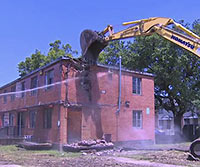 Yesterday, this Komatsu finished the job that Hurricane Ike started, taking out 63 damaged units of the Houston Housing Authority’s Kelly Village Apartments at 1119 Grove St. in the Fifth Ward — and at least one of the residents is happy to see ’em go: “Lacrecha St. Jules,” who wrote a letter to the Housing Authority requesting that something be done, reports the Houston Chronicle, “spent plenty of sleepless nights worrying about her four children as drug dealers and thugs made themselves at home in [the] vacant buildings. . . . ‘It was dark, and there were rapes back there . . . It was a bunch of negatives, and I just wanted to turn it into a positive.'” North of I-10 and east of U.S. 59, the apartments, which showed up in yesterday’s Daily Demolition Report, date to 1930; the city says it plans to build an $800,000, 3-acre park in their place, with room for a jogging trail and garden. [Houston Chronicle; previously on Swamplot] Photo: KHOU via Facebook
Yesterday, this Komatsu finished the job that Hurricane Ike started, taking out 63 damaged units of the Houston Housing Authority’s Kelly Village Apartments at 1119 Grove St. in the Fifth Ward — and at least one of the residents is happy to see ’em go: “Lacrecha St. Jules,” who wrote a letter to the Housing Authority requesting that something be done, reports the Houston Chronicle, “spent plenty of sleepless nights worrying about her four children as drug dealers and thugs made themselves at home in [the] vacant buildings. . . . ‘It was dark, and there were rapes back there . . . It was a bunch of negatives, and I just wanted to turn it into a positive.'” North of I-10 and east of U.S. 59, the apartments, which showed up in yesterday’s Daily Demolition Report, date to 1930; the city says it plans to build an $800,000, 3-acre park in their place, with room for a jogging trail and garden. [Houston Chronicle; previously on Swamplot] Photo: KHOU via Facebook
IS HISD KEEPING REBUILDING JOBS FROM MINORITY-OWNED FIRMS? 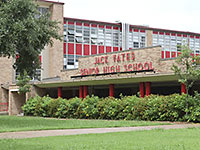 That’s what the Houston chapter of the National Organization of Minority Architects (or HNOMA) seems to suspect, having sent a letter to HISD superintendent Terry Grier alleging “disenfranchisement” and wanting to know why so few jobs funded by last year’s $1.89 billion bond to rebuild 40 schools have been awarded to African-American-owned firms, reports Hair Balls: “Only two percent of the monies assigned have gone to the six [Houston-area] architectural firms run solely by African-American owners,” says Jeff Balke. “According to the letter, it appears that none of the six firms in question were even interviewed for projects pertaining to the four traditionally African-American high schools being rebuilt,” one of which is Yates High School, shown here. Adds HNOMA veep Anzilla Gilmore: “In the 2007 Bond, all of these firms got work, so we assumed that with a Bond this big, these guys shouldn’t have any issues. . . . They just need the chance, and if they don’t get the chance, they should be told why.” [HISD; Hair Balls; previously on Swamplot] Photo: HISD
That’s what the Houston chapter of the National Organization of Minority Architects (or HNOMA) seems to suspect, having sent a letter to HISD superintendent Terry Grier alleging “disenfranchisement” and wanting to know why so few jobs funded by last year’s $1.89 billion bond to rebuild 40 schools have been awarded to African-American-owned firms, reports Hair Balls: “Only two percent of the monies assigned have gone to the six [Houston-area] architectural firms run solely by African-American owners,” says Jeff Balke. “According to the letter, it appears that none of the six firms in question were even interviewed for projects pertaining to the four traditionally African-American high schools being rebuilt,” one of which is Yates High School, shown here. Adds HNOMA veep Anzilla Gilmore: “In the 2007 Bond, all of these firms got work, so we assumed that with a Bond this big, these guys shouldn’t have any issues. . . . They just need the chance, and if they don’t get the chance, they should be told why.” [HISD; Hair Balls; previously on Swamplot] Photo: HISD
HOW ITALIAN ARTISTS GET STUCK IN GALVESTON 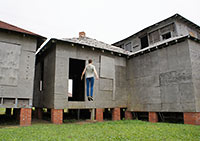 Art writer Debra Barrera gets the inside scoop on some of the banana-peel art put up by Italian artist Davide Savorani for this past weekend’s exhibition at the Galveston Artist Residency compound at the corner of 25th St. and Ships Mechanic Row: “Savorani explains The Can’t Get Away Club as part of the nature of living in a place like Galveston; the calm sea breeze, the cheap booze, and endless reasons to never return to a big city can keep people stuck. Each year promises are made, ‘Maybe next year I will move to Houston . . . Maybe I will finally start that popcorn ball franchise.’ From Firenze, a small town in the north of Italy himself, Savorani is familiar with this syndrome and decided to immerse himself in Galveston: ‘I came here with nothing and I wanted to try to understand the city. Something I experienced was this idea of a place where you really face yourself.'” And face others who are celebrating, apparently, Barrera continues: “What I admired most about both Savorani and [his assistant, Michelangelo] Miccolis was their ability to immerse themselves in a completely foreign place and use materials that were part of their daily lives. In the studio, when I asked about a strand of plastic beads hanging on the wall, Miccolis remarked, ‘Yes! We were at some parade and they were just throwing them! We kept grabbing at the air! This is what the city gave us; why not make art out of it?’†[Glasstire] Self-portrait at cottages between 28th and Winnie: Michelangelo Miccolis
Art writer Debra Barrera gets the inside scoop on some of the banana-peel art put up by Italian artist Davide Savorani for this past weekend’s exhibition at the Galveston Artist Residency compound at the corner of 25th St. and Ships Mechanic Row: “Savorani explains The Can’t Get Away Club as part of the nature of living in a place like Galveston; the calm sea breeze, the cheap booze, and endless reasons to never return to a big city can keep people stuck. Each year promises are made, ‘Maybe next year I will move to Houston . . . Maybe I will finally start that popcorn ball franchise.’ From Firenze, a small town in the north of Italy himself, Savorani is familiar with this syndrome and decided to immerse himself in Galveston: ‘I came here with nothing and I wanted to try to understand the city. Something I experienced was this idea of a place where you really face yourself.'” And face others who are celebrating, apparently, Barrera continues: “What I admired most about both Savorani and [his assistant, Michelangelo] Miccolis was their ability to immerse themselves in a completely foreign place and use materials that were part of their daily lives. In the studio, when I asked about a strand of plastic beads hanging on the wall, Miccolis remarked, ‘Yes! We were at some parade and they were just throwing them! We kept grabbing at the air! This is what the city gave us; why not make art out of it?’†[Glasstire] Self-portrait at cottages between 28th and Winnie: Michelangelo Miccolis
‘WHERE’S OUR SHADE?’ 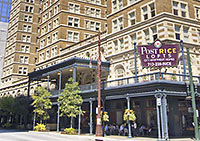 Shade, Houston Chronicle columnist Lisa Gray writes, is “cheap, efficient, and delicious.” Spurning the air-conditioned tunnels on a walk Downtown, Gray stops to cool off beneath “the deep sheltered walkway in front of the Post Rice Lofts,” she writes, and starts to heat up with questions: “If Houston knew how to create such excellent, pedestrian-friendly shade in 1912, when the Rice Hotel was built, why don’t we make more shady places like that a hundred years later? Where are new buildings’ sheltered walkways, their canopies and loggias, their arcades and awnings? . . . Why do we make do with little patio umbrellas, scrawny canvas awnings over doorways, narrow overhangs that work only if you hug the building at noon?” [Houston Chronicle ($)] Photo: Finding Camelot
Shade, Houston Chronicle columnist Lisa Gray writes, is “cheap, efficient, and delicious.” Spurning the air-conditioned tunnels on a walk Downtown, Gray stops to cool off beneath “the deep sheltered walkway in front of the Post Rice Lofts,” she writes, and starts to heat up with questions: “If Houston knew how to create such excellent, pedestrian-friendly shade in 1912, when the Rice Hotel was built, why don’t we make more shady places like that a hundred years later? Where are new buildings’ sheltered walkways, their canopies and loggias, their arcades and awnings? . . . Why do we make do with little patio umbrellas, scrawny canvas awnings over doorways, narrow overhangs that work only if you hug the building at noon?” [Houston Chronicle ($)] Photo: Finding Camelot
COMMENT OF THE DAY: A LITTLE 411 ON THAT 2010 $6 MILLION 380 SOUTH OF I-10 “For the record, the Ainbinder 380 Agreement did not include drainage detention, they simply tied into existing storm sewer systems — there were no ‘improvements.’ The road was widened at the expense of a tree-lined sidewalk. The sidewalk was ‘abandoned,’ which means ‘is no longer in existence.’ There are no street tree wells and/or no ROW accounted for to plant shade-bearing street trees. The removal of $250K worth of mature Live Oaks resulted in a transfer of this public amenity to Walmart’s parking lot. Yes, that’s right. Public trees were allowed to be replanted on Walmart’s parking lot. And, oh yeah, the four-sided intersection has just two pedestrian signalized crossings. Yes, you can’t actually safely cross on two sides because there are no lights and markings. Why? Because PW&E missed it and the developer didn’t end up having to pay for it. The ‘bridge improvement’ is the biggest boondoggle of them all. Ainbinder wanted to pave it and area civic orgs fought them. Turns out, after coring was performed on the bridge, that the dead load was far greater than known AS A RESULT OF previous paving. That was the second load limit drop. So, Ainbinder window-dressed and spent 380 monies for cosmetic treatments — changing out balustrades and painting A BRIDGE THAT WILL BE TORN DOWN. That is an absurd waste of taxpayer money. Unlike other 380s, the Ainbinder 380 had next to no specifications that ensured deliverables. There were no clawback provisions to ensure public return on the investment. Once the money is awarded to the developer, they can strike or change line items and they still get full payment. The development doesn’t even have to perform to produce new taxes (not just poached taxes), it can be a miserable failure and they still get paid. The folks that were championing this development are now trying to pretend the public infrastructure results were worth $6,000,000 of public money. Guess what? You were wrong then and you’re still wrong now. The proof is right there for everyone to see. Own it.” [TexasSpiral, commenting on Headlines: Getting to the Washington Heights Walmart; Learning Lessons from Hurricane Ike]
FIGHTING THE INVADERS OF BUFFALO BAYOU  Though much of the Buffalo Bayou Partnership’s (BBP) plans for that eponymous waterway involve adding things — kayak rental shops, pedestrian bridges, etc. — there seems to be the need for subtraction, too: “‘People look at the park and see that it’s filled with trees and grass, what most people don’t realize is that most of those plants shouldn’t be there,'” BBP’s prez Anne Olson tells Alex Wukman of Free Press Houston. “A study of the park’s vegetation, which the Partnership filed with the Texas Forest Service, found Buffalo Bayou to be overrun with invasive species — primarily White Cedar and Chinese Tallow. . . . Olson explained that the Partnership plans to combat the invasive species problem by removing 50 percent of the park’s lawn, which is mostly made up of easily-maintained but non-native Bermuda grass, and replacing it with native grasses.” Adds Olson: “‘We’re going to create an 11 acre urban prairie.'” [Free Press Houston; previously on Swamplot] Photo: Flickr user barryDphotography
Though much of the Buffalo Bayou Partnership’s (BBP) plans for that eponymous waterway involve adding things — kayak rental shops, pedestrian bridges, etc. — there seems to be the need for subtraction, too: “‘People look at the park and see that it’s filled with trees and grass, what most people don’t realize is that most of those plants shouldn’t be there,'” BBP’s prez Anne Olson tells Alex Wukman of Free Press Houston. “A study of the park’s vegetation, which the Partnership filed with the Texas Forest Service, found Buffalo Bayou to be overrun with invasive species — primarily White Cedar and Chinese Tallow. . . . Olson explained that the Partnership plans to combat the invasive species problem by removing 50 percent of the park’s lawn, which is mostly made up of easily-maintained but non-native Bermuda grass, and replacing it with native grasses.” Adds Olson: “‘We’re going to create an 11 acre urban prairie.'” [Free Press Houston; previously on Swamplot] Photo: Flickr user barryDphotography
HOW HOUSTON’S AIR GOT BETTER  During the past decade, Houston’s notoriously polluted air has become — well, if not quite good, then not quite as bad, says NPR’s Richard Harris. (Pay no attention to what that ozone app may or may not tell you.) How? Well, it seems that pollution regulators in the early aughts had been worrying about all the wrong gases: “They were going all-in against [only] one of the pollutants that create smog, while downplaying the role of other emissions from the petrochemical plants,” reports Harris. “Barges carting chemicals up and down the [Ship Channel] were leaking. . . . And some types of storage tanks were leaking as well. . . . It turns out that routine day-to-day emissions were not the biggest problem.” Since then, regulations targeting those chemicals, like ethylene — as well as the use of infrared cameras that can spot them — appear to have made a difference: Port of Houston Authority employee Dana Blume tells Harris: “I can look out of my office window now and almost every single day see downtown.” [NPR; previously on Swamplot] Photo: Flickr user stmu_mike
During the past decade, Houston’s notoriously polluted air has become — well, if not quite good, then not quite as bad, says NPR’s Richard Harris. (Pay no attention to what that ozone app may or may not tell you.) How? Well, it seems that pollution regulators in the early aughts had been worrying about all the wrong gases: “They were going all-in against [only] one of the pollutants that create smog, while downplaying the role of other emissions from the petrochemical plants,” reports Harris. “Barges carting chemicals up and down the [Ship Channel] were leaking. . . . And some types of storage tanks were leaking as well. . . . It turns out that routine day-to-day emissions were not the biggest problem.” Since then, regulations targeting those chemicals, like ethylene — as well as the use of infrared cameras that can spot them — appear to have made a difference: Port of Houston Authority employee Dana Blume tells Harris: “I can look out of my office window now and almost every single day see downtown.” [NPR; previously on Swamplot] Photo: Flickr user stmu_mike

